Global Traction Battery Cathode Material Industrial Chain Trade Analysis: A Multilayer Modeling Approach
Abstract
1. Introduction
2. Literature Review
3. Data and Methodology
3.1. Data
3.2. Network Construction
3.3. Methodology
3.3.1. Network Indices
3.3.2. Versatile Countries Mining in Multilayer Network
4. Results
4.1. Growing Trend in the Global Traction Battery Trade
4.2. Multilayer Network Structure
4.3. Versatile Countries in a Global Traction Battery Network
5. Discussion
6. Conclusions
Author Contributions
Funding
Institutional Review Board Statement
Data Availability Statement
Conflicts of Interest
References
- IEA. Global EV Outlook 2023; International Energy Agency: Paris, France, 2023. [Google Scholar]
- Hao, H.; Xing, W.; Wang, A.; Song, H.; Han, Y.; Zhao, P.; Xie, Z.; Chen, X. Multi-layer networks research on analyzing supply risk transmission of lithium industry chain. Resour. Policy 2022, 79, 102933. [Google Scholar] [CrossRef]
- Chen, G.; Kong, R.; Wang, Y. Research on the evolution of lithium trade communities based on the complex network. Phys. A Stat. Mech. Its Appl. 2020, 540, 123002. [Google Scholar] [CrossRef]
- Zhao, Y.; Gao, X.; An, H.; Xi, X.; Sun, Q.; Jiang, M. The effect of the mined cobalt trade dependence Network’s structure on trade price. Resour. Policy 2020, 65, 101589. [Google Scholar] [CrossRef]
- Sun, X.; Hao, H.; Liu, Z.; Zhao, F.; Song, J. Tracing global cobalt flow: 1995–2015. Resour. Conserv. Recycl. 2019, 149, 45–55. [Google Scholar] [CrossRef]
- Shao, L.; Kou, W.; Zhang, H. The evolution of the global cobalt and lithium trade pattern and the impacts of the low-cobalt technology of lithium batteries based on multiplex network. Resour. Policy 2022, 76, 102550. [Google Scholar] [CrossRef]
- Van den Brink, S.; Kleijn, R.; Sprecher, B.; Tukker, A. Identifying supply risks by mapping the cobalt supply chain. Resour. Conserv. Recycl. 2020, 156, 104743. [Google Scholar] [CrossRef]
- Koenig, G.M., Jr.; Belharouak, I.; Deng, H.; Sun, Y.-K.; Amine, K. Composition-tailored synthesis of gradient transition metal precursor particles for lithium-ion battery cathode materials. Chem. Mater. 2011, 23, 1954–1963. [Google Scholar] [CrossRef]
- Fergus, J.W. Recent developments in cathode materials for lithium ion batteries. J. Power Sources 2010, 195, 939–954. [Google Scholar] [CrossRef]
- Lee, S.; Manthiram, A. Can cobalt be eliminated from lithium-ion batteries? ACS Energy Lett. 2022, 7, 3058–3063. [Google Scholar] [CrossRef]
- Bridge, G.; Faigen, E. Towards the lithium-ion battery production network: Thinking beyond mineral supply chains. Energy Res. Soc. Sci. 2022, 89, 102659. [Google Scholar] [CrossRef]
- Tan, J.; Keiding, J.K. Mapping the cobalt and lithium supply chains for e-mobility transition: Significance of overseas investments and vertical integration in evaluating mineral supply risks. Resour. Conserv. Recycl. 2024, 209, 107788. [Google Scholar] [CrossRef]
- Gonzales-Calienes, G.; Kannangara, M.; Bensebaa, F. Economic and environmental viability of lithium-ion battery recycling—Case study in two Canadian regions with different energy mixes. Batteries 2023, 9, 375. [Google Scholar] [CrossRef]
- Kampker, A.; Heimes, H.H.; Offermanns, C.; Frieges, M.H.; Graaf, M.; Soldan Cattani, N.; Späth, B. Cost-benefit analysis of downstream applications for retired electric vehicle batteries. World Electr. Veh. J. 2023, 14, 110. [Google Scholar] [CrossRef]
- Simon, B.; Weil, M. Analysis of materials and energy flows of different lithium ion traction batteries. Metall. Res. Technol. 2013, 110, 65–76. [Google Scholar] [CrossRef]
- De Domenico, M.; Solé-Ribalta, A.; Omodei, E.; Gómez, S.; Arenas, A. Ranking in interconnected multilayer networks reveals versatile nodes. Nat. Commun. 2015, 6, 6868. [Google Scholar] [CrossRef]
- Tian, X.; Geng, Y.; Sarkis, J.; Gao, C.; Sun, X.; Micic, T.; Hao, H.; Wang, X. Features of critical resource trade networks of lithium-ion batteries. Resour. Policy 2021, 73, 102177. [Google Scholar] [CrossRef]
- Kivelä, M.; Arenas, A.; Barthelemy, M.; Gleeson, J.P.; Moreno, Y.; Porter, M.A. Multilayer networks. J. Complex Netw. 2014, 2, 203–271. [Google Scholar] [CrossRef]
- Watari, T.; McLellan, B.C.; Giurco, D.; Dominish, E.; Yamasue, E.; Nansai, K. Total material requirement for the global energy transition to 2050: A focus on transport and electricity. Resour. Conserv. Recycl. 2019, 148, 91–103. [Google Scholar] [CrossRef]
- Li, Y.; Yang, J.; Song, J. Design structure model and renewable energy technology for rechargeable battery towards greener and more sustainable electric vehicle. Renew. Sustain. Energy Rev. 2017, 74, 19–25. [Google Scholar] [CrossRef]
- Guo, X.; Zhang, J.; Tian, Q. Modeling the potential impact of future lithium recycling on lithium demand in China: A dynamic SFA approach. Renew. Sustain. Energy Rev. 2021, 137, 110461. [Google Scholar] [CrossRef]
- Song, J.; Yan, W.; Cao, H.; Song, Q.; Ding, H.; Lv, Z.; Zhang, Y.; Sun, Z. Material flow analysis on critical raw materials of lithium-ion batteries in China. J. Clean. Prod. 2019, 215, 570–581. [Google Scholar] [CrossRef]
- Zhou, N.; Su, H.; Wu, Q.; Hu, S.; Xu, D.; Yang, D.; Cheng, J. China’s lithium supply chain: Security dynamics and policy countermeasures. Resour. Policy 2022, 78, 102866. [Google Scholar] [CrossRef]
- El Hadri, H.; Mirza, D.; Rabaud, I. Natural disasters and countries’ exports: New insights from a new (and an old) database. World Econ. 2019, 42, 2668–2683. [Google Scholar] [CrossRef]
- Sturla-Zerene, G.; Figueroa, E.; Sturla, M. Reducing GHG global emissions from copper refining and sea shipping of Chile’s mining exports: A world win-win policy. Resour. Policy 2020, 65, 101565. [Google Scholar] [CrossRef]
- Kim, T.-Y.; Gould, T.; Bennet, S.; Briens, F.; Dasgupta, A.; Gonzales, P.; Gouy, A.; Kamiya, G.; Karpiniski, M.; Lagelee, J. The Role of Critical Minerals in Clean Energy Transitions; International Energy Agency: Washington, DC, USA, 2021; pp. 70–71. [Google Scholar]
- Khurshid, A.; Chen, Y.; Rauf, A.; Khan, K. Critical metals in uncertainty: How Russia-Ukraine conflict drives their prices? Resour. Policy 2023, 85, 104000. [Google Scholar] [CrossRef]
- Tabassum, S.; Pereira, F.S.; Fernandes, S.; Gama, J. Social network analysis: An overview. Wiley Interdiscip. Rev. Data Min. Knowl. Discov. 2018, 8, e1256. [Google Scholar] [CrossRef]
- Pavlopoulos, G.A.; Wegener, A.-L.; Schneider, R. A survey of visualization tools for biological network analysis. Biodata Min. 2008, 1, 12. [Google Scholar] [CrossRef]
- Hu, X.; Wang, C.; Zhu, X.; Yao, C.; Ghadimi, P. Trade structure and risk transmission in the international automotive Li-ion batteries trade. Resour. Conserv. Recycl. 2021, 170, 105591. [Google Scholar] [CrossRef]
- Gupta, V.; He, B.; Sethi, S.P. Contingent sourcing under supply disruption and competition. Int. J. Prod. Res. 2015, 53, 3006–3027. [Google Scholar] [CrossRef]
- Interdonato, R.; Magnani, M.; Perna, D.; Tagarelli, A.; Vega, D. Multilayer network simplification: Approaches, models and methods. Comput. Sci. Rev. 2020, 36, 100246. [Google Scholar] [CrossRef]
- Boccaletti, S.; Bianconi, G.; Criado, R.; Del Genio, C.I.; Gómez-Gardenes, J.; Romance, M.; Sendina-Nadal, I.; Wang, Z.; Zanin, M. The structure and dynamics of multilayer networks. Phys. Rep. 2014, 544, 1–122. [Google Scholar] [CrossRef] [PubMed]
- De Domenico, M.; Solé-Ribalta, A.; Cozzo, E.; Kivelä, M.; Moreno, Y.; Porter, M.A.; Gómez, S.; Arenas, A. Mathematical formulation of multilayer networks. Phys. Rev. X 2013, 3, 041022. [Google Scholar] [CrossRef]
- Peng, P.; Claramunt, C.; Cheng, S.; Yang, Y.; Lu, F. A multi-layer modelling approach for mining versatile ports of a global maritime transportation network. Int. J. Digit. Earth 2023, 16, 2129–2151. [Google Scholar] [CrossRef]
- Danziger, M.M.; Bonamassa, I.; Boccaletti, S.; Havlin, S. Dynamic interdependence and competition in multilayer networks. Nat. Phys. 2019, 15, 178–185. [Google Scholar] [CrossRef]
- Song, H.; Luo, G.; Ji, Z.; Bo, R.; Xue, Z.; Yan, D.; Zhang, F.; Bai, K.; Liu, J.; Cheng, X. Highly-integrated, miniaturized, stretchable electronic systems based on stacked multilayer network materials. Sci. Adv. 2022, 8, eabm3785. [Google Scholar] [CrossRef]
- Danziger, M.M.; Barabási, A.-L. Recovery coupling in multilayer networks. Nat. Commun. 2022, 13, 955. [Google Scholar] [CrossRef]
- Aleta, A.; Moreno, Y. Multilayer networks in a nutshell. Annu. Rev. Condens. Matter Phys. 2019, 10, 45–62. [Google Scholar] [CrossRef]
- Muldoon, S.F.; Bassett, D.S. Network and multilayer network approaches to understanding human brain dynamics. Philos. Sci. 2016, 83, 710–720. [Google Scholar] [CrossRef]
- Finn, K.R.; Silk, M.J.; Porter, M.A.; Pinter-Wollman, N. The use of multilayer network analysis in animal behaviour. Anim. Behav. 2019, 149, 7–22. [Google Scholar] [CrossRef]
- Gao, C.; Sun, M.; Shen, B. Features and evolution of international fossil energy trade relationships: A weighted multilayer network analysis. Appl. Energy 2015, 156, 542–554. [Google Scholar] [CrossRef]
- Du, W.-B.; Zhou, X.-L.; Lordan, O.; Wang, Z.; Zhao, C.; Zhu, Y.-B. Analysis of the Chinese Airline Network as multi-layer networks. Transp. Res. Part E Logist. Transp. Rev. 2016, 89, 108–116. [Google Scholar] [CrossRef]
- Peng, P.; Poon, J.P.; Xie, X. COVID-19 Medical Trade: Multilayer Network Analysis and Network Determinants. Netw. Spat. Econ. 2023, 24, 27–48. [Google Scholar] [CrossRef]
- Ashton, D.J.; Jarrett, T.C.; Johnson, N.F. Effect of congestion costs on shortest paths through complex networks. Phys. Rev. Lett. 2005, 94, 058701. [Google Scholar] [CrossRef] [PubMed]
- Albert, R.; Barabási, A.-L. Statistical mechanics of complex networks. Rev. Mod. Phys. 2002, 74, 47. [Google Scholar] [CrossRef]
- Noldus, R.; Van Mieghem, P. Assortativity in complex networks. J. Complex Netw. 2015, 3, 507–542. [Google Scholar] [CrossRef]
- Kleinberg, J.M. Authoritative sources in a hyperlinked environment. J. ACM 1999, 46, 604–632. [Google Scholar] [CrossRef]
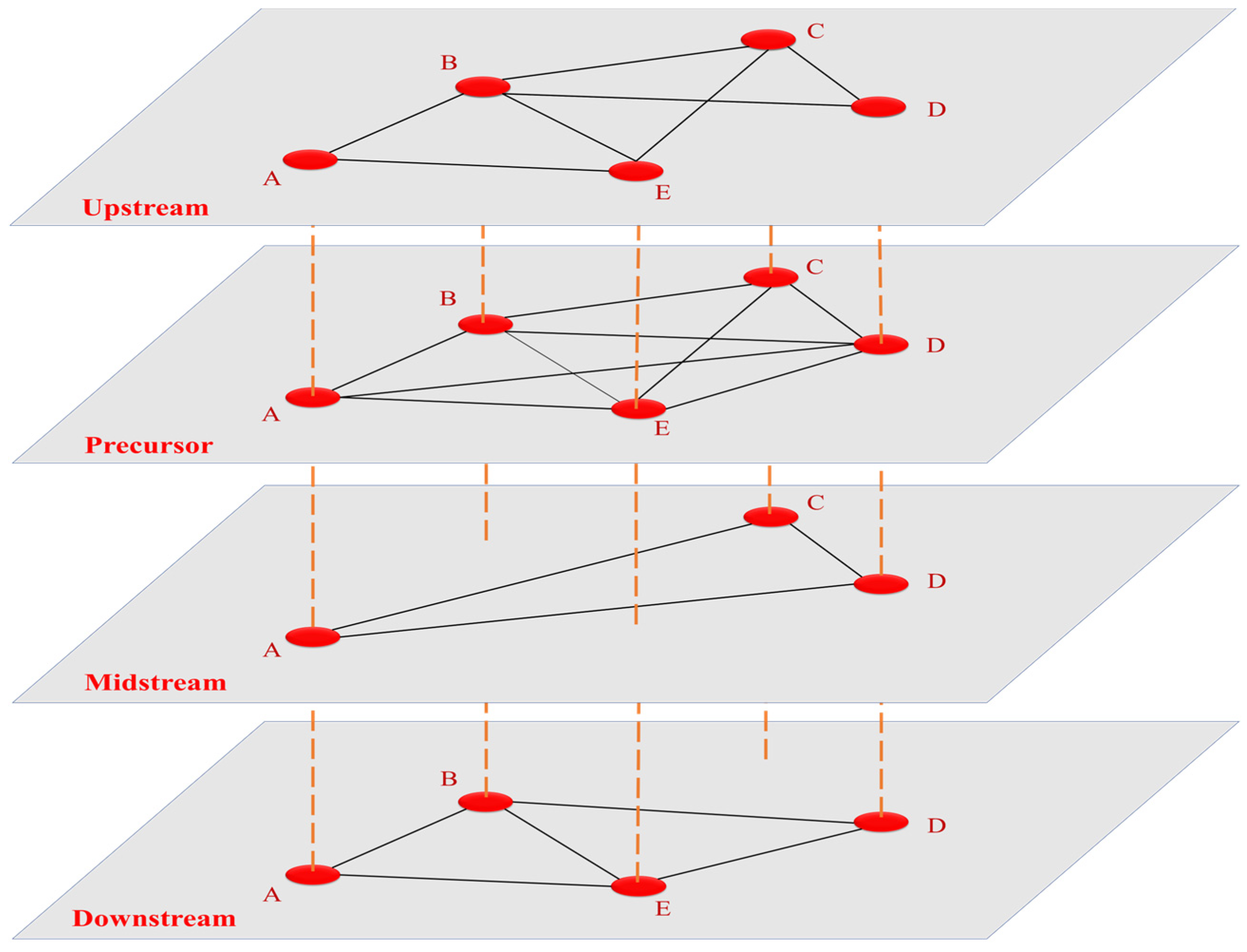
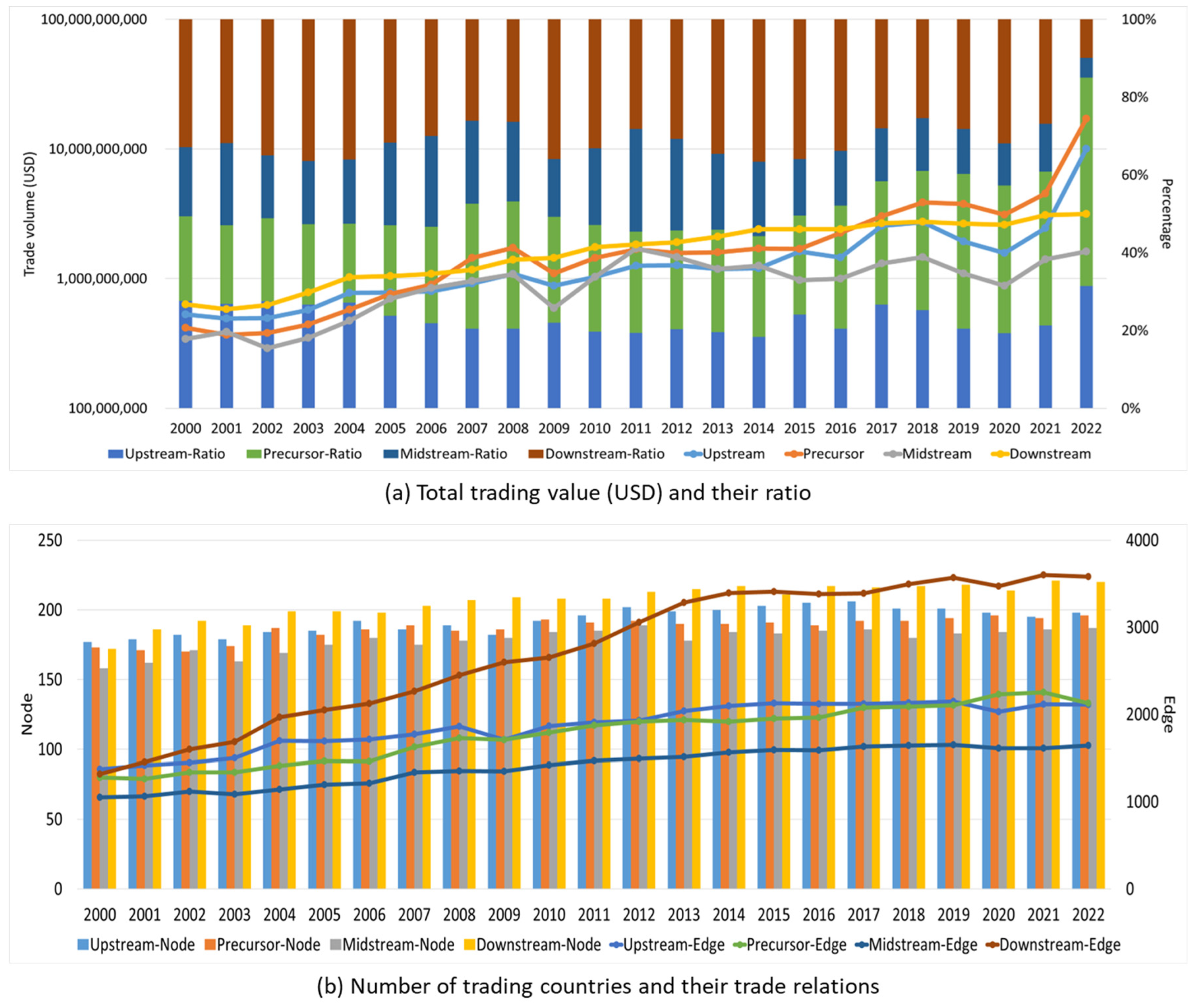
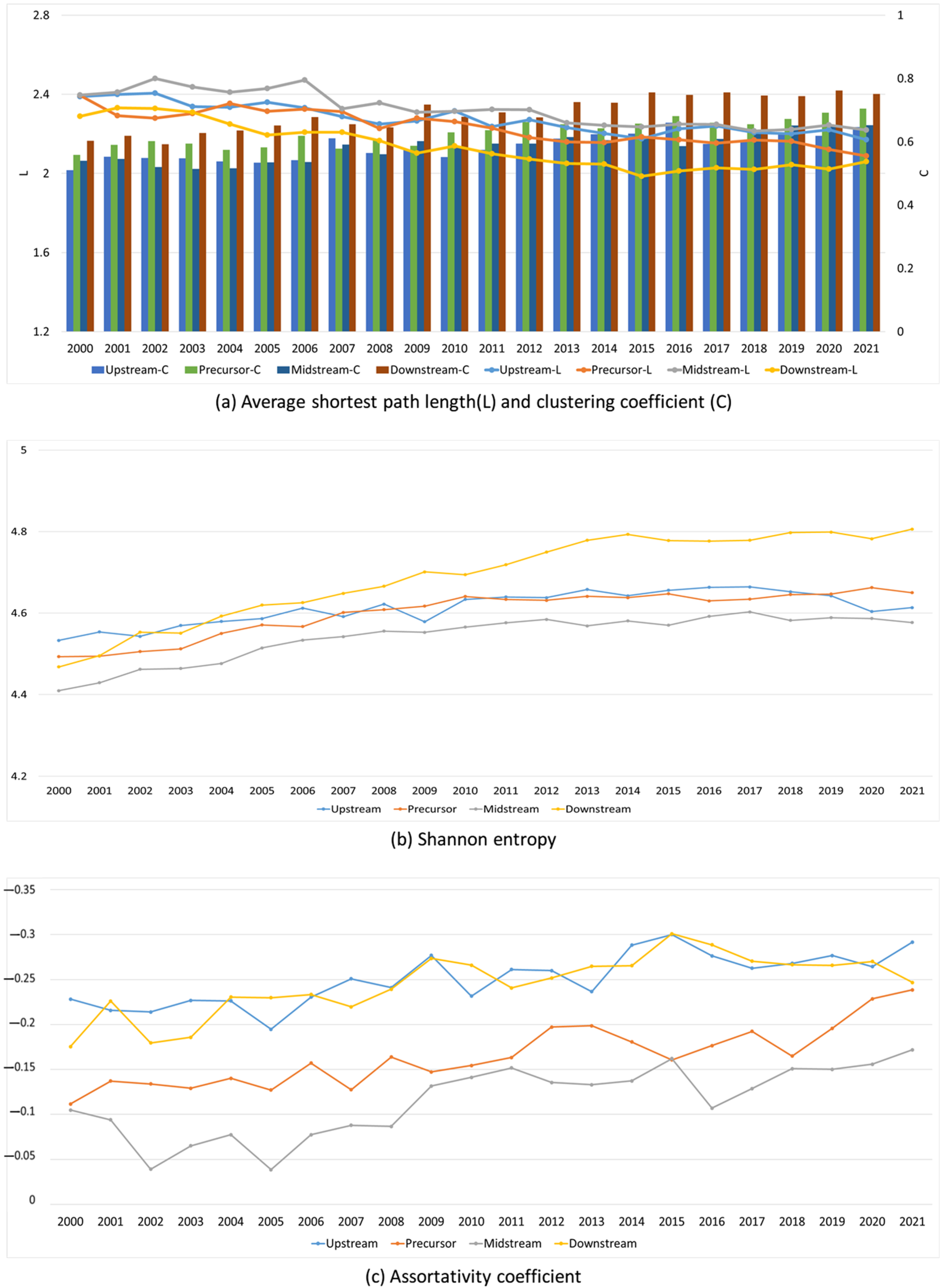
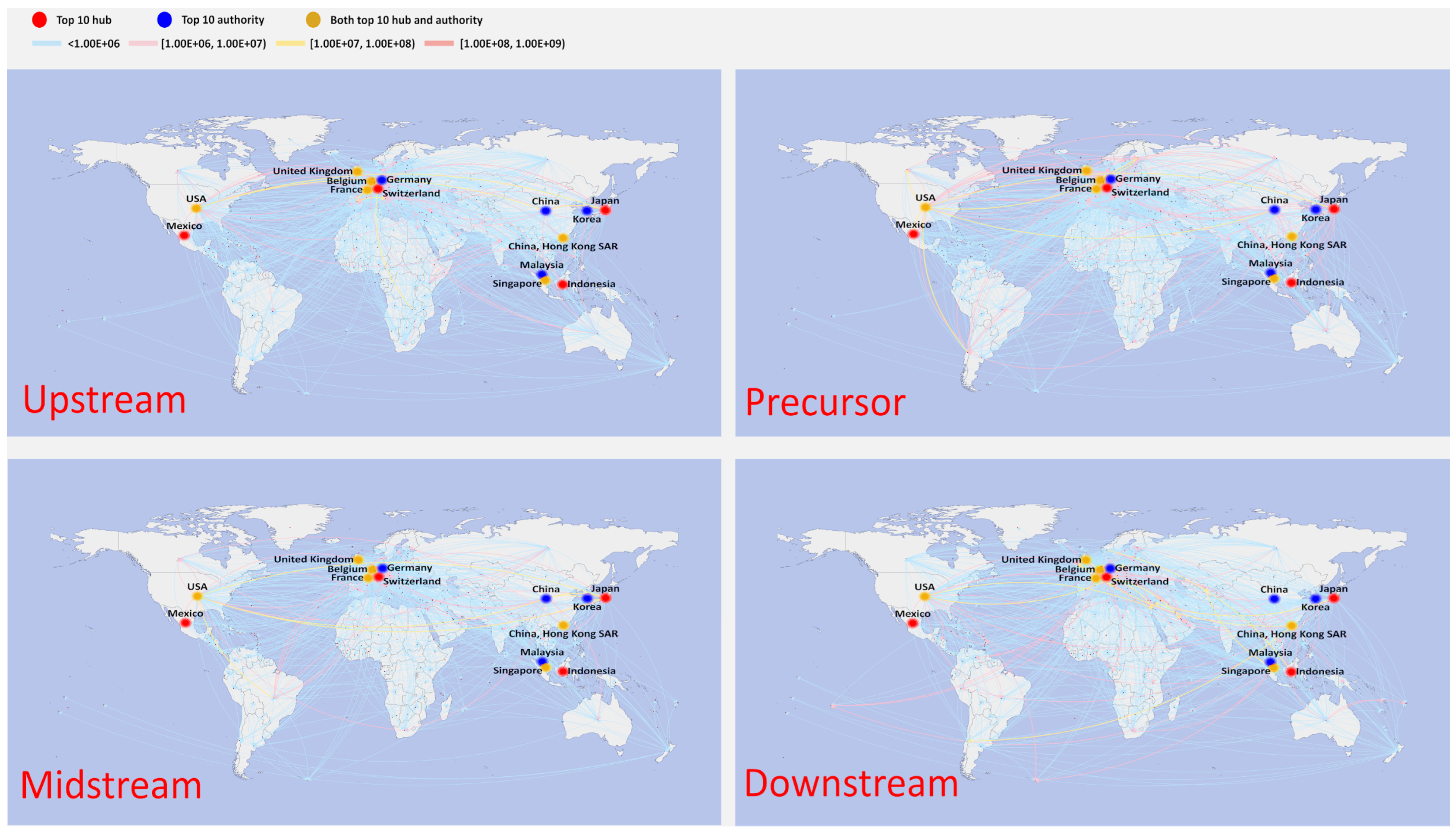
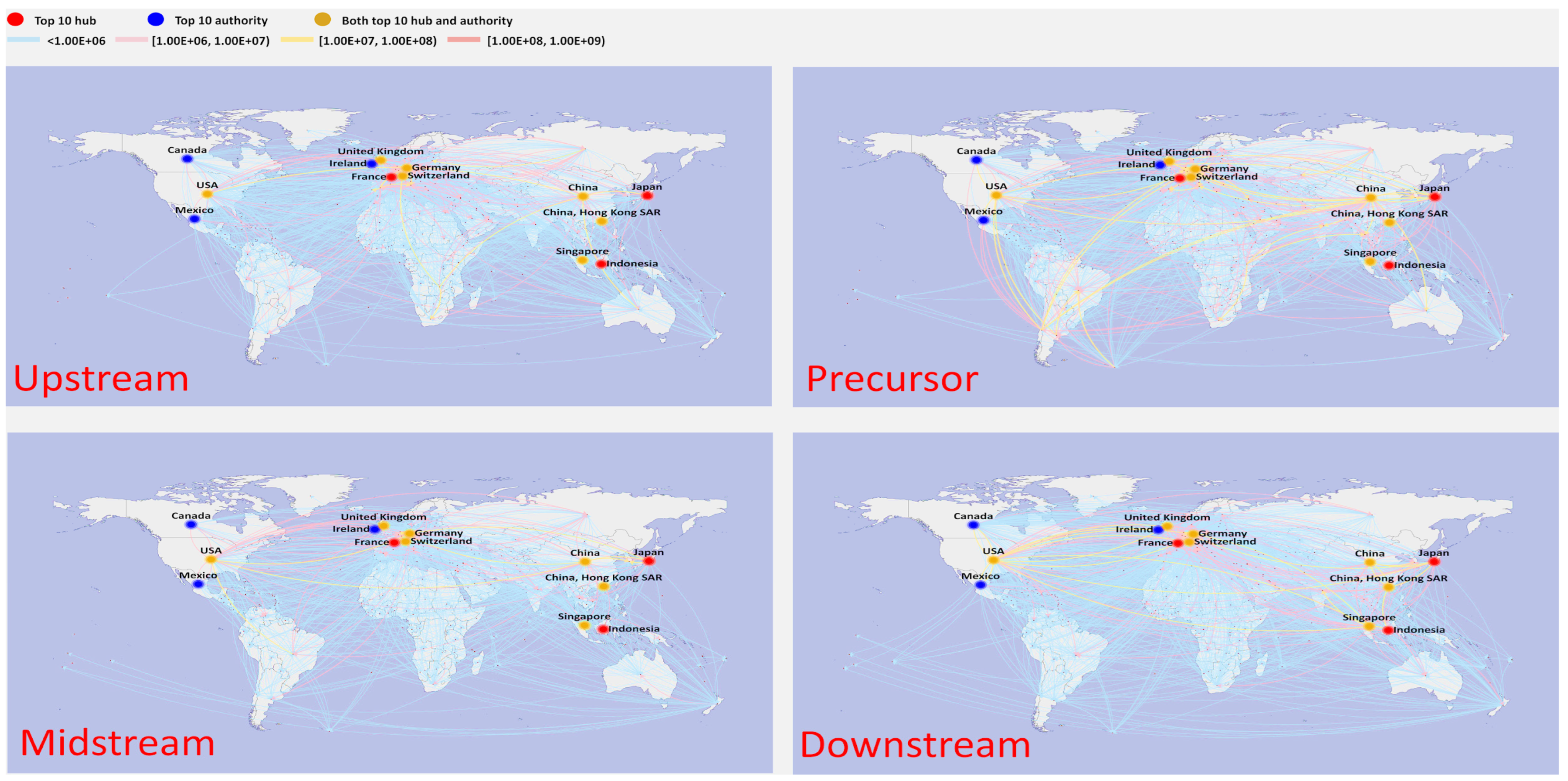

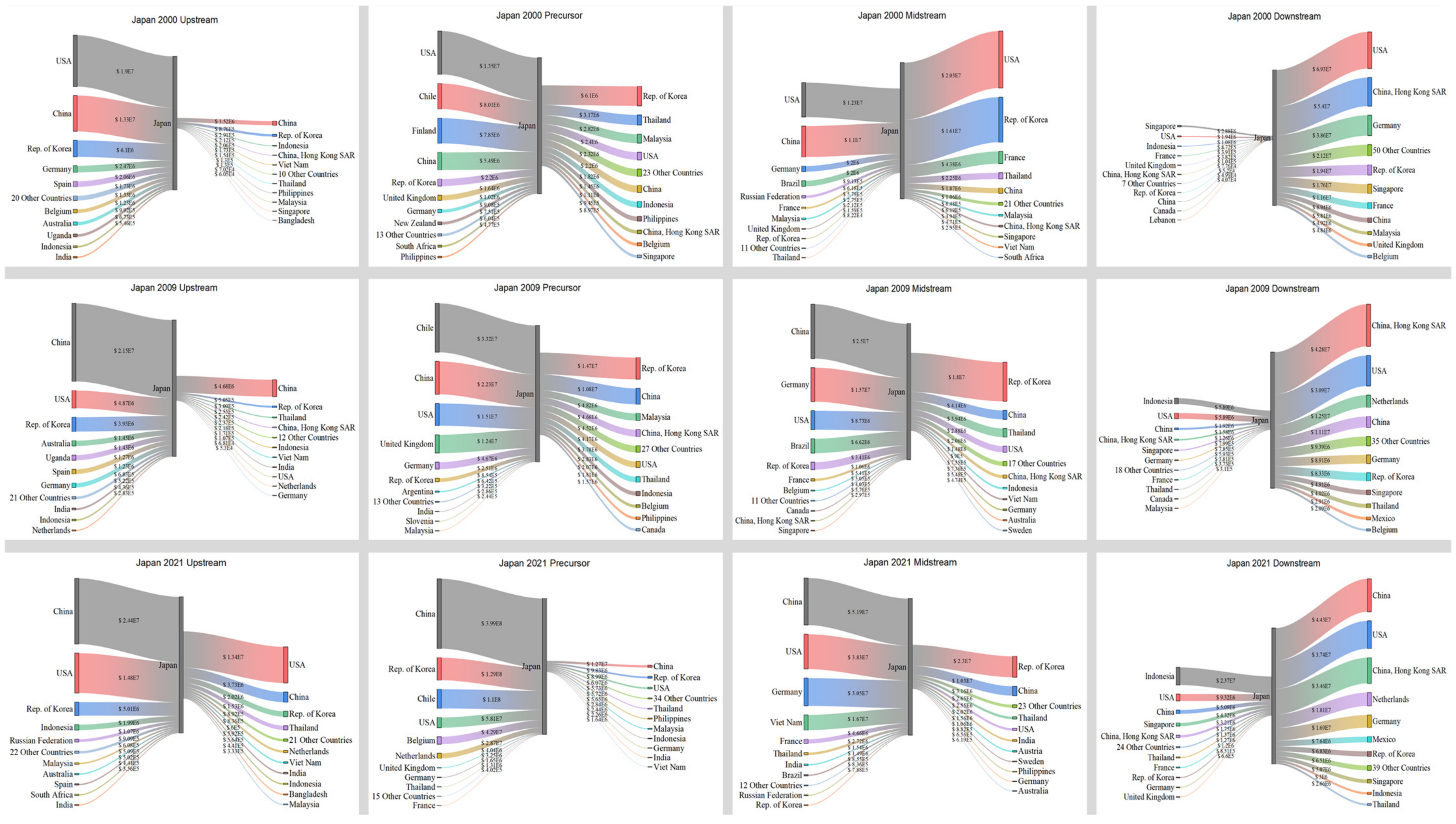

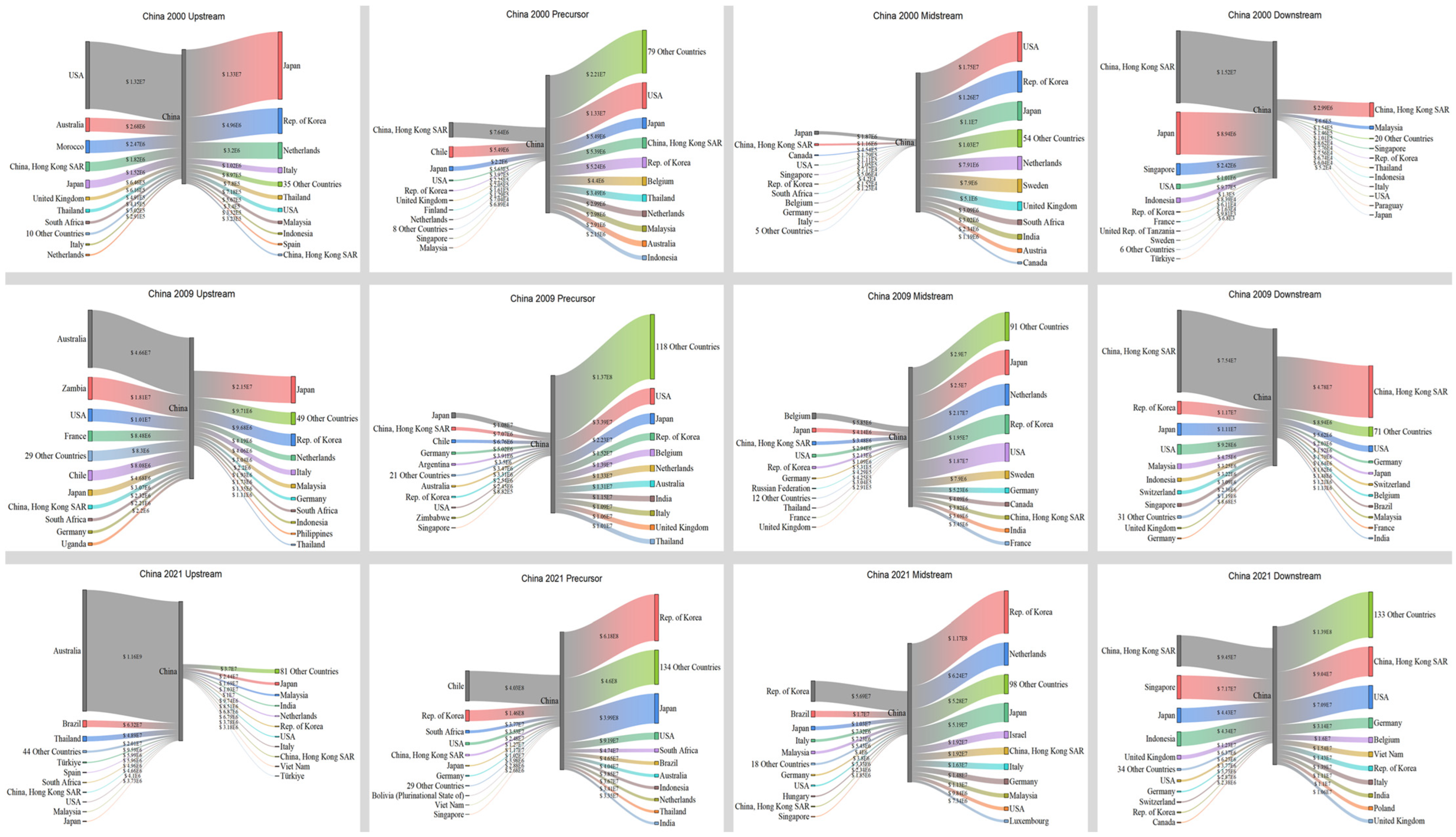
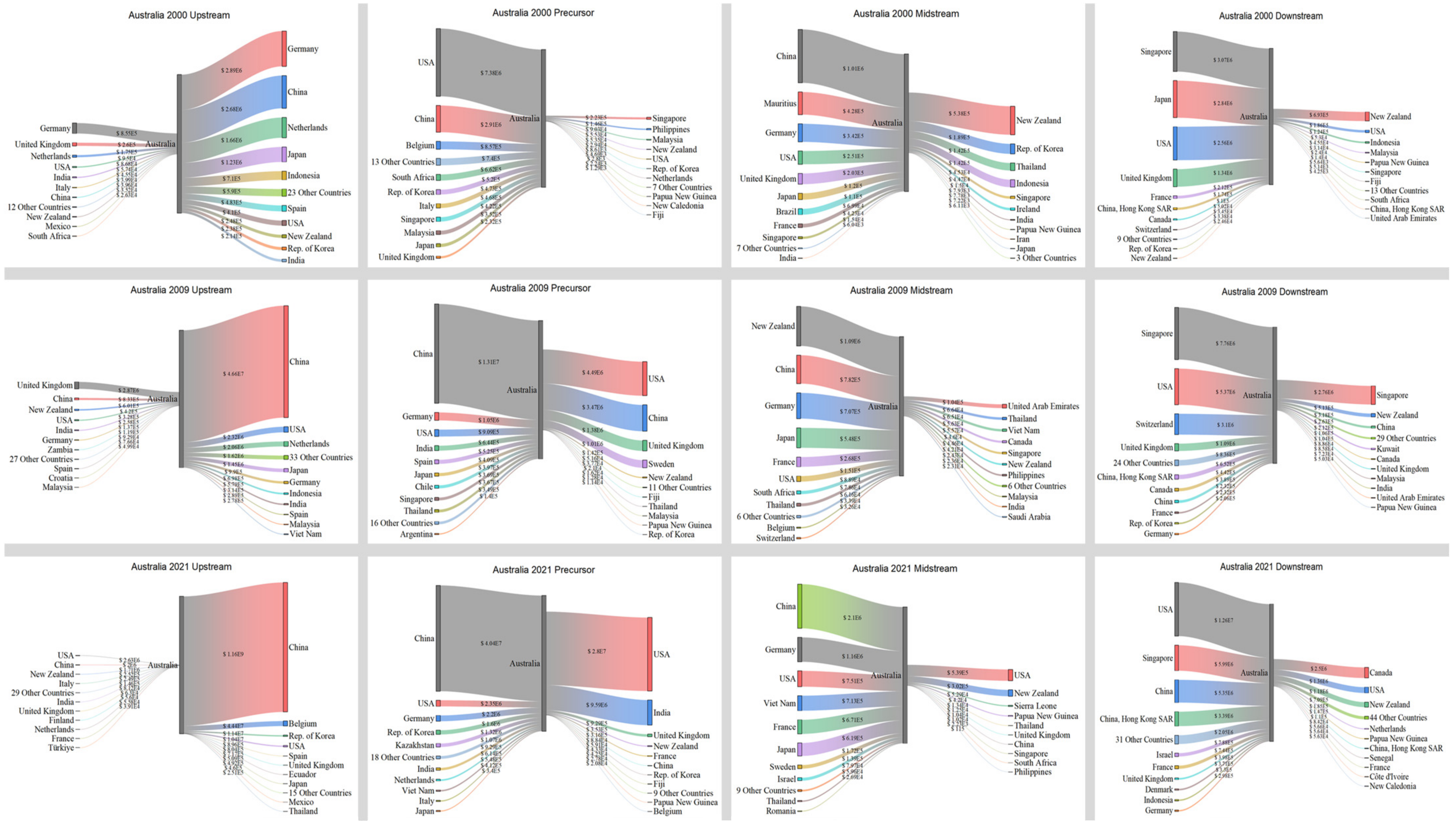
| Code | Description | |
|---|---|---|
| Upstream | 253090 | Lithium. Lithium is commonly utilized in the cathode electrolyte salts of lithium-ion batteries and other related cathode materials. |
| 260500 | Cobalt. The cobalt industry primarily supplies the lithium-ion battery sector. Lithium cobalt (III), a cobalt chemical, is extensively utilized in lithium-ion batteries. | |
| Precursor | 282520 | Lithium hydroxide. Lithium hydroxide is an important precursor for the preparation of electrolyte materials for traction batteries. |
| 283321 | Manganous sulfate. Manganese sulfate is primarily utilized in lithium-ion batteries for the synthesis of the precursor of the cathode ternary material. | |
| 283324 | Nickel sulfate. Nickel sulfate is primarily utilized in lithium-ion batteries for the synthesis of the precursor of the cathode ternary material. | |
| 283329 | Cobaltous sulfate. Cobaltous sulfate is primarily utilized in lithium-ion batteries for the synthesis of the precursor of the cathode ternary material. | |
| 283691 | Lithium carbonate. Lithium carbonate is a typical building block for lithium-ion battery cathode materials, particularly ternary compositions (LiCoO2, etc.) and those without cobalt (LiFePO4). | |
| Midstream | 282590 | Lithium cobalt oxides. A crucial component of lithium-ion battery cathode material. |
| 283529 | Iron phosphate. A crucial component of lithium-ion battery cathode material. | |
| 284169 | Lithium manganate. A crucial component of lithium-ion battery cathode material. | |
| Downstream | 850650 | Lithium-ion battery. A final product for traction batteries. |
| Top 10 Hub Countries | ||||||
|---|---|---|---|---|---|---|
| Rank | 2000 | 2009 | 2021 | |||
| Country | Value | Country | Value | Country | Value | |
| 1 | Japan | 1.0000 | USA | 1.0000 | Australia | 1.0000 |
| 2 | Mexico | 0.0938 | Japan | 0.2370 | Brazil | 0.0544 |
| 3 | France | 0.0810 | China, Hong Kong SAR | 0.2154 | Thailand | 0.0422 |
| 4 | USA | 0.0792 | Singapore | 0.1698 | Türkiye | 0.0083 |
| 5 | UK | 0.0530 | China | 0.1428 | Spain | 0.0052 |
| 6 | Belgium | 0.0527 | Germany | 0.0985 | South Africa | 0.0051 |
| 7 | Switzerland | 0.0385 | France | 0.0953 | China, Hong Kong SAR | 0.0043 |
| 8 | Indonesia | 0.0378 | Indonesia | 0.0827 | USA | 0.0041 |
| 9 | Singapore | 0.0289 | UK | 0.0741 | Malaysia | 0.0035 |
| 10 | China, Hong Kong SAR | 0.0269 | Switzerland | 0.0578 | Japan | 0.0033 |
| Top 10 Authority Countries | ||||||
| 1 | USA | 1.0000 | Ireland | 1.0000 | China | 1.0000 |
| 2 | China, Hong Kong SAR | 0.7614 | Mexico | 0.9896 | Belgium | 0.0381 |
| 3 | Germany | 0.5652 | Switzerland | 0.7339 | Korea | 0.0098 |
| 4 | Korea | 0.2719 | UK | 0.6761 | USA | 0.0090 |
| 5 | Singapore | 0.2527 | China | 0.5055 | Spain | 0.0008 |
| 6 | France | 0.1772 | China, Hong Kong SAR | 0.4926 | UK | 0.0007 |
| 7 | China | 0.1333 | Canada | 0.4790 | Ecuador | 0.0006 |
| 8 | UK | 0.0884 | Germany | 0.3943 | Japan | 0.0005 |
| 9 | Malaysia | 0.0881 | USA | 0.2980 | Mexico | 0.0005 |
| 10 | Belgium | 0.0755 | Singapore | 0.2670 | Thailand | 0.0002 |
| (a) Top 5 Hub Countries in Different Layers | ||||||||
|---|---|---|---|---|---|---|---|---|
| Rank | Upstream | Precursor | Midstream | Downstream | ||||
| Country | Value | Country | Value | Country | Value | Country | Value | |
| 1 | Netherlands | 1.0000 | Finland | 1.0000 | China | 1.0000 | Japan | 1.0000 |
| 2 | Spain | 0.4778 | Chile | 0.9620 | Japan | 0.9273 | Mexico | 0.0938 |
| 3 | Germany | 0.1461 | China | 0.7152 | Brazil | 0.4879 | France | 0.0810 |
| 4 | USA | 0.1355 | USA | 0.6079 | Canada | 0.2774 | USA | 0.0792 |
| 5 | Belgium | 0.1270 | Mexico | 0.3644 | Germany | 0.2392 | UK | 0.0530 |
| (b) Top 5 Authority Countries in Different Layers | ||||||||
| 1 | Germany | 1.0000 | USA | 1.0000 | USA | 1.0000 | USA | 1.0000 |
| 2 | Belgium | 0.6693 | Japan | 0.5216 | Korea | 0.5771 | China, Hong Kong SAR | 0.7614 |
| 3 | France | 0.3348 | Germany | 0.3556 | Japan | 0.3033 | Germany | 0.5652 |
| 4 | Italy | 0.1723 | Belgium | 0.3234 | Netherlands | 0.2268 | Korea | 0.2719 |
| 5 | Japan | 0.1089 | Netherlands | 0.3202 | Sweden | 0.1677 | Singapore | 0.2527 |
| Top 5 Hub Countries in Different Layers | ||||||||
|---|---|---|---|---|---|---|---|---|
| Rank | Upstream | Precursor | Midstream | Downstream | ||||
| Country | Value | Country | Value | Country | Value | Country | Value | |
| 1 | Zambia | 1.0000 | China | 1.0000 | China | 1.0000 | USA | 1.0000 |
| 2 | Australia | 0.9265 | Germany | 0.8069 | Germany | 0.5999 | Japan | 0.2370 |
| 3 | USA | 0.2365 | Chile | 0.6933 | Brazil | 0.4185 | China, Hong Kong SAR | 0.2154 |
| 4 | Spain | 0.2317 | Argentina | 0.3919 | Japan | 0.1918 | Singapore | 0.1698 |
| 5 | France | 0.1989 | Mexico | 0.3411 | USA | 0.1883 | China | 0.1428 |
| Top 5 Authority Countries in Different Layers | ||||||||
| 1 | China | 1.0000 | USA | 1.0000 | USA | 1.0000 | Ireland | 1.0000 |
| 2 | South Africa | 0.6627 | Japan | 0.6976 | Japan | 0.9636 | Mexico | 0.9896 |
| 3 | Switzerland | 0.2159 | Belgium | 0.5418 | Netherlands | 0.7405 | Switzerland | 0.7339 |
| 4 | France | 0.1328 | Korea | 0.4810 | Korea | 0.5840 | UK | 0.6761 |
| 5 | Italy | 0.1289 | Italy | 0.4768 | Germany | 0.2682 | China | 0.5055 |
| Top 5 Hub Countries in Different Layers | ||||||||
|---|---|---|---|---|---|---|---|---|
| Rank | Upstream | Precursor | Midstream | Downstream | ||||
| Country | Value | Country | Value | Country | Value | Country | Value | |
| 1 | Australia | 1.0000 | China | 1.0000 | China | 1.0000 | Singapore | 1.0000 |
| 2 | Brazil | 0.0544 | Chile | 0.5737 | Viet Nam | 0.2591 | China | 0.8257 |
| 3 | Thailand | 0.0422 | Korea | 0.1409 | USA | 0.2076 | China, Hong Kong SAR | 0.6340 |
| 4 | Türkiye | 0.0083 | USA | 0.0670 | Germany | 0.1429 | Japan | 0.5578 |
| 5 | Spain | 0.0052 | Russia | 0.0470 | Japan | 0.1256 | Indonesia | 0.5397 |
| Top 5 Authority Countries in Different Layers | ||||||||
| 1 | China | 1.0000 | Korea | 1.0000 | Korea | 1.0000 | USA | 1.0000 |
| 2 | Belgium | 0.0381 | Japan | 0.6108 | Netherlands | 0.5424 | China | 0.8277 |
| 3 | Korea | 0.0098 | China | 0.3211 | Japan | 0.5404 | China, Hong Kong SAR | 0.6880 |
| 4 | USA | 0.0090 | USA | 0.1584 | USA | 0.1752 | Germany | 0.3002 |
| 5 | Spain | 0.0008 | Belgium | 0.0648 | Israel | 0.1539 | Netherlands | 0.2892 |
Disclaimer/Publisher’s Note: The statements, opinions and data contained in all publications are solely those of the individual author(s) and contributor(s) and not of MDPI and/or the editor(s). MDPI and/or the editor(s) disclaim responsibility for any injury to people or property resulting from any ideas, methods, instructions or products referred to in the content. |
© 2024 by the authors. Licensee MDPI, Basel, Switzerland. This article is an open access article distributed under the terms and conditions of the Creative Commons Attribution (CC BY) license (https://creativecommons.org/licenses/by/4.0/).
Share and Cite
Peng, P.; Xu, Y.; Yu, L.; Xie, X. Global Traction Battery Cathode Material Industrial Chain Trade Analysis: A Multilayer Modeling Approach. Entropy 2024, 26, 895. https://doi.org/10.3390/e26110895
Peng P, Xu Y, Yu L, Xie X. Global Traction Battery Cathode Material Industrial Chain Trade Analysis: A Multilayer Modeling Approach. Entropy. 2024; 26(11):895. https://doi.org/10.3390/e26110895
Chicago/Turabian StylePeng, Peng, Yang Xu, Li Yu, and Xiaowei Xie. 2024. "Global Traction Battery Cathode Material Industrial Chain Trade Analysis: A Multilayer Modeling Approach" Entropy 26, no. 11: 895. https://doi.org/10.3390/e26110895
APA StylePeng, P., Xu, Y., Yu, L., & Xie, X. (2024). Global Traction Battery Cathode Material Industrial Chain Trade Analysis: A Multilayer Modeling Approach. Entropy, 26(11), 895. https://doi.org/10.3390/e26110895








